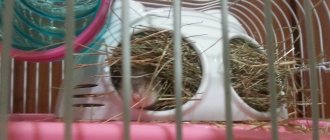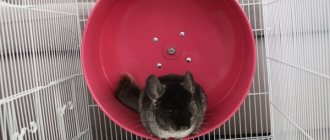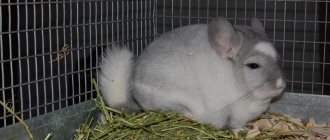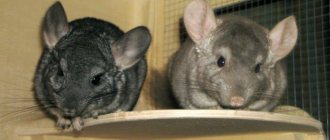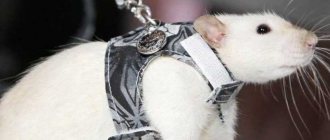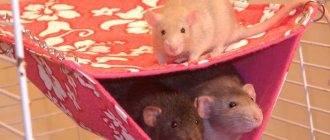- home
- Parrot
- Arrangement
04/13/2019 Budgerigars that live in the wild look for old trees with convenient hollows to build their nests. Having chosen the tree you like, they thoroughly clean the future breeding house of debris and even trample down the wood dust at the bottom. Birds choose places where they will feel safe during the nesting period.
In captivity, their owners help them settle in. What a comfortable nesting house for budgerigars should be like is described in this article.
Types of nesting houses
There is no need for parrot owners to go into the forest to find a littered, dried tree with a large hollow. A parrot house, practical and safe, can be purchased ready-made or made by yourself.
The choice is between rectangular structures, which differ in the ratio of width, length and height. Each option has its own advantages and disadvantages. The common feature is wood as a material for production and the size of the hole is approximately 50 mm in diameter. The female will be able to expand the cage if necessary. She uses her beak, which she uses to bite off excess wood.
Horizontal design
A parrot house with a width and length of 20x25 cm and a height of 15 cm is called horizontal. The site is quite spacious. It is convenient for the female to hatch eggs and climb into the house without damaging the clutch.
The downside is the following: the height of the house is small, the entrance hole is located very low. Still immature chicks can fall out.
Vertical design
A house with a width and length of 20 cm, a height of 25 cm is called vertical. Little chicks will not get out of the nest ahead of time. But the exit from the house is located at a high altitude. If the female climbs into it carelessly, there is a risk of crushing the eggs or chicks that hatch last.
Compromise option
A compromise solution is the size of the house 25x20 cm, 20 cm high. The area is sufficient for the female to move around. Small parrots will not have the opportunity to accidentally crawl out. A step, which is made at the bottom under a 6x3 cm perch, helps the female to safely settle on the clutch. The chicks will be safe.
Arrangement
To make it easier for the female to move and make it easier to fly in and out, a wooden plank 3 to 5 cm high should be nailed to the bottom under the entrance hole from the inside (this step occupies a third of the bottom).
It is important to line the floor with bedding because a smooth surface will cause the eggs to roll out into the corners. To do this, special materials are used that help retain heat; it is advisable to use natural raw materials, such as sawdust mixed with dried chamomile. This bedding also helps protect offspring and birds from parasites. It is enough to make a layer up to 2 centimeters.
During nesting, it is not recommended to clean the nest or change sawdust, so as not to disturb the feathered mother.
How to make a nesting house?
The design of the nesting house is simple, you need a minimum of materials, the most basic tools. You can use improvised means. The main thing is to have the desire to make a nest for budgies with your own hands.
What materials will be needed?
Materials for making a house must meet the following requirements:
- environmental friendliness and safety for the feathered family;
- the ability to carry out disinfection if necessary.
The best option is wood. You can remake the simplest apple box. It is easy to make a structure from plywood. It's better not to take chipboard. A small house made of particle board will be heated by birds and emit harmful fumes. In addition, birds can peck at shavings that are treated with an adhesive composition. Making a house from MDF is not the best solution, since parrots are capable of pecking at such material.
In addition to wood for the walls, bottom and roof, you should prepare:
- wooden stick-perch;
- nails or screws;
- roof hinges.
What tool will you need?
If you plan to use nails to knock together the walls, you will need a hammer. Some craftsmen prefer to use self-tapping screws. In this case, you need a Phillips screwdriver or screwdriver. To take measurements, you will need a ruler or tape measure, pen or pencil.
A round hole for birds is marked using a compass and cut out by hand with a hacksaw with a very narrow blade, a drill saw or a round file. It is most convenient to do these manipulations with a jigsaw or electric hacksaw.
Design and manufacturing
Before you start making a nest for a parrot, you need to decide on its size. If the choice falls on compromise dimensions, you need to prepare templates of the following sizes from paper or cardboard:
- 25x20 cm for two side walls.
- 20X20 cm for the front and back walls.
- 20x25 cm for floor and roof.
Using cardboard templates, cut out plywood parts. You should have 4 walls, a roof and a bottom. The roof is placed on hinges, which are attached immediately. The bottom of the cage should be as close as possible to the nest structure that parrots make in nature. This can be achieved by cutting a circle into the bottom with a jigsaw. From another piece you need to cut a circle with a slightly larger diameter and attach it to the back of the bottom. In this way, a nest with a recess is obtained.
The walls are connected using nails or self-tapping screws. The roof is attached to vent or piano hinges. A taphole is cut out on the façade wall, having previously marked a circle using a compass. A hole is made under it for a perch. It should extend 30 mm inside and protrude 100 mm outside. These parameters are enough for the female to comfortably climb inside.
Holes for ventilation with a diameter of up to 1 cm are made on the side walls. This is very important for birds, otherwise small chicks may suffocate and the female will have difficulty breathing. Larger holes should not be made to prevent the chicks from getting cold.
Making a parrot's nest is easier than it seems at first glance. If you have the necessary tools and materials, the entire process will take no more than 2–3 hours.
What you need to prepare for the design
If you plan to create a nest yourself, then you need to prepare the following elements:
- drawing of the future nest;
- wooden boards, and they can be obtained by destroying an ordinary wooden box;
- boards can be replaced with plywood, but it is not recommended to use chipboard, as this material is of low quality;
- screws and hammer;
- wooden perch;
- special fastenings with which the nest is fixed to the walls of the cage.
It is advisable to treat with antiseptics before connecting all the parts, which will greatly simplify the work.
The photo shows one of the drawing options for making a nest:
How to arrange a nest?
The nesting house is washed and scalded with boiling water. When it dries, you can begin arrangement. In the wild, the female makes a depression at the bottom of the hollow. Trash and other debris in the form of slivers of feathers and droppings left over from previous birds are thrown out of the nest by the female. But very fine wood dust remains, which removes the hardness of the bottom and serves as thermal insulation.
In captivity the situation is different from the conditions in the wild. Even if you make a hole in a plywood box, this does not guarantee comfort for the birds. Most breeders believe that the best solution is to use sawdust for bedding.
There is no need to install heating devices in the house. The female will cope with heating the offspring on her own. If for some reason the room is very cold, an incandescent lamp can be placed close to the cage, at a safe distance from the birds.
Nest for budgies: buy or make it yourself?
Before a pair of wavy birds gets ready to breed, you need to make a nest, it is also called a nesting house. This is an important stimulus for the female to lay eggs.
Nesting houses are usually divided into vertical (imagine a kind of narrow mini-birdhouse), horizontal (the principle is the same, only instead of height the house is stretched in width), and a mixed type (the so-called compromise house).
The mixed type combines sufficient width and a high entrance for the female (entry). Thus, in such a nest the disadvantages of the two previous types of nest are solved, and here:
- it is difficult for parrots to fall out or jump out in the first days of life, which means they will be healthier
- the female will not crush the chicks by flying into the house, since the entrance is high above the chicks
- due to its large width, the nesting area is spacious for the female and offspring
How to use sawdust?
The female has an instinct to clean the nest before settling into it. Therefore, as soon as the house is installed, she will conduct an “audit”.
To prevent the female from immediately throwing sawdust out of the nest, add a small amount of it. Fine sawdust is mixed with a pinch of dry chamomile to prevent ticks. You can completely replace sawdust with crushed chamomile.
Subsequently, when the chicks begin to hatch, larger sawdust can be placed in the parrots’ nest. Parrots will grab them with their paws and train them. The number of helicopter pilots will decrease.
The sawdust will keep the chicks warm and safe. Breeders do not limit the choice of wood type for sawdust.
How many days do lovebird parrots hatch eggs?
Often people buy lovebirds for their home. They gained such popularity thanks to simple living conditions, bright plumage, activity and curiosity. Over time, the birds mature and create pairs. And now they need human help to create good conditions for the birth of healthy chicks. Let's look at how to properly make a nest for lovebirds, what conditions they need and how long lovebirds sit on their eggs.
What are the pros and cons of a pet store house?
The nest for a budgerigar should be suitable for the female and chicks. But this doesn't always happen.
A nesting house purchased at a pet store is made of chipboard material, which is harmful to birds. Wooden nests are available, but they are very expensive.
Shop houses are not knocked down or twisted with screws, but glued together. The adhesive mixture is unknown. There is no guarantee that dangerous fumes will not be released.
The thickness of the walls and floors in a purchased house rarely exceeds 10 mm. It will be difficult for the female to warm the clutch, and the hatched chicks will be cold.
Ready-made models
You can purchase or order a special nesting house in the store. Such models are already equipped with metal hooks, most of them have all the necessary parameters, are safe, equipped with hinged lids, perches, and convenient entry. There are models made from natural coconuts, wood, dried meadow grass stalks, plastic, metal rods, and fabric. The assortment is very large and varied, sometimes it is easier to buy a ready-made option than to make a nest with your own hands.
What are the pros and cons of a custom nesting house?
When the owner of the parrots does not have the desire or time to deal with making a house on his own, it is better to order it.
Advantages of this solution:
- the client’s wishes are taken into account;
- production time is discussed;
- The workmanship is usually excellent.
Difficulties that may arise:
- it is impossible to find craftsmen;
- long production time;
- high price for work.
These disadvantages are not always present. Craftsmen can be found on the Internet or in the nearest carpentry shop, and they can negotiate at a reasonable price. Conscientious craftsmen fulfill orders quickly and efficiently.
Preparatory work
We start by cutting out all the necessary parts. You should get 4 rectangular blanks with dimensions 25*20 (two walls, bottom and roof) and 2 square blanks 20*20 (side walls). In one of the rectangular blanks we cut out a circle with a diameter of 5 cm. This is the future entrance through which the parrots will penetrate inside. Approximately 2 cm below the tap hole we drill a hole, the diameter of which coincides with the diameter of the perch.
On the front wall (the same one with the entrance) you can attach hooks by which the house will be suspended from the cage. If the cage is large and the nest box is planned to be placed directly inside it, hooks are not needed.
You also need to take care of the bottom, because you need to make a recess in it. It will serve as a nest in which the female will lay eggs so that they do not roll out throughout the house. To make a recess, you need to cut a circle with a diameter of 6 cm into the bottom. Then nail a small piece of board from below to close the hole.
All details are ready. If you plan to fasten them not with nails, but with screws, then additionally drill holes for them.
When and where to place a nest?
The mating season of domestic budgerigars does not depend on the season, as in the wild. In Australia, these birds breed in the summer, when nature has the optimal amount of nutritious and vitamin-rich food. At home, the optimal temperature and appropriate feed depend on the breeder.
If you plan to breed parrots, the diet is enriched with food containing vitamins E and D. Do not forget to place a mineral stone (chalk) in the cage as the birds eat it. Daylight hours should be at least 15 hours. Sometimes additional lighting is required. The temperature in the room is not lower than +15℃.
The fact that the nesting of budgerigars is just around the corner and it’s time to build a house is indicated by the beginning of mating games in a pair of different-sex parrots. At this time, the male persistently courts his girlfriend, who does not reject the advances. Birds may begin to pluck each other’s feathers, “coo” among themselves for a long time, and kiss. The parrot begins to knock on all hard objects in the cage, on the female’s beak, and nod its head. He brings his friend treats, she accepts them.
There are such couples when during the mating season the female does not eat anything until her friend brings her a treat. As soon as a nest is installed in the cage, the female, ready to breed offspring, will begin to inhabit it.
Experienced breeders believe that serious couples should not delay installing a house. Expectant parents need to be sure that they have a place to hatch and feed their babies.
The house is fixed outside the cage or placed inside. The first option is suitable for small cell areas due to space saving. The parrots themselves will like it better if the nest is installed inside. This way the female will be calmer. The male often settles on the roof, and the female hears it.
The cage can have any shape, but it must be spacious. A prerequisite is a removable roof. Otherwise, it will not be possible to keep the nest clean and disinfect the home. The steel bars of the cage must be quite strong and thick to securely fix the house.
The entire structure should be in a warm room. Dampness and drafts are unacceptable. During the period when the female sits on the clutch, and also subsequently when feeding occurs, the birds need peace and quiet. If the room is noisy, the couple will be disturbed, and they may abandon the chicks.
Smoking in the room where budgies are located is prohibited. This applies not only to the period when they breed. Birds cannot tolerate tobacco smoke.
Reproduction of lovebirds
Lovebirds are very beautiful and interesting birds, and they are also very good because they are able to reproduce in captivity if the most comfortable conditions are created for them.
Fortunately, this is not as difficult as it might seem at first glance, and there are much fewer problems with lovebirds than with budgies.
The main task of lovebirds, as you might guess from the name of this type of parrot, is to choose a partner for reproduction.
It is noteworthy that these birds choose a partner once for their entire life and experience quite a hard time if their partner dies.
Moreover, if for other animals choosing a partner is not difficult, for lovebirds this is a very difficult task, since they are monogamous.
That is why they approach the issue of choosing a partner with particular selectivity.
If lovebirds meet each other, then they will not have any problems in the matter of reproduction.
The male always cares for the female, and if you pay attention to these lovely creatures, you will immediately notice that the male carefully cleans the female’s feathers, feeds her from his beak and shows signs of attention.
In general, the partners care for each other and their attraction is obvious, therefore, they are guaranteed to start mating.
Nest house care
The first cleaning is planned when the chicks are two weeks old. The lid must be opened and the chicks quickly and carefully removed from the nest and placed in a prepared cardboard box. Egg shells and droppings are removed from the nest and the bedding is changed.
When the chicks leave the house, they are disinfected. Chemicals and chlorine-containing preparations cannot be used. It is enough to scald a wooden house with boiling water. If there is a need to use detergents, these can be baby soap, laundry soap and baking soda.
Cleaning is done weekly. If the birds have a very negative attitude towards this process, it is better to leave them alone. Such a stressful situation will not lead to anything good.
If the couple has trust in the owner, they are not aggressive, and they clean regularly. The birds are allowed to fly around the room, the babies are seated. Even if the parrots are loyal to this process, this must be done quickly, without abusing the patience of the couple.
How many steps does it take to hatch a Larvesta egg?
- Data Pokemon Data Pokédex
- moves
- Type table
- Capabilities
- PC.
- Evolution chains
- Pokemon locations
- Sprite gallery
- Links
- National Pokédex
- List of Pokemon with statistics
- Pokédex of Ultra Sun and Ultra Moon
- Let's go, Pikachu / Eevee Pokédex
- Pokédex Sword & Shield
- Breeding and egg groups
- Sword and shield
Excess weight
Lovebirds have a tendency to become obese. This disease disrupts the functioning of the bird’s internal organs; such individuals are not inclined to nest. Before mating, the birds are put on a rice diet for 7 days. It includes rice porridge with water, greens, and sprouted grains. It is recommended to open the cage more often to allow the birds to fly around the room. This way they train the heart muscle and lose excess weight.
After a week of dietary nutrition, fruits and vegetables are introduced into the diet. You shouldn’t lose weight too much, especially for females. They may not survive the entire nesting period, and problems with egg laying will begin.
Acceptable Materials
Birds love to chew on perches, toys and twigs. To prevent toxic substances from entering the body, the parrot's cage must be made of safe materials. Cheap house models made from materials of dubious quality threaten the health of pets. Galvanized rods can cause poisoning to a parrot. No less dangerous is copper, which quickly oxidizes. Its oxides act as a strong poison on birds.
Wooden parrot cages are only suitable for temporary housing. Budgerigars gnaw through them with ease. Wood absorbs moisture, becoming a favorable environment for the growth of bacteria.
A good option is a plastic structure. This material is non-toxic, but is susceptible to high temperatures. Therefore, houses made from it cannot be washed with hot water.
Horizontal dwelling
This design is suitable for a female and her offspring. The young animals will look out of the house and watch what is happening. In general, this design is almost similar to a vertical house. For production you will need:
- Cut a couple of rectangular boards from the board, each 25x15 cm. This will become the front wall and floor.
- After this, you will need to make the side walls in the same way. It is better to use them in size 15x14 cm.
- Then from plywood you should cut out the back wall measuring 23x15 and the roof for housing 25x15 cm.
- Next, you need to secure the front part and bottom with nails, and then secure the side walls.
- When the base of the structure is assembled, you can begin to drill the entrance. The diameter for a budgerigar remains the same 5 cm.
- A perch should be secured a little below the entrance.
- Then along the top of the back wall you need to drill a few holes, with an equal distance from one another. Similar holes will need to be made along the edges of the roof. It is very important that the holes coincide with each other. Next, using a regular rope, you need to secure the roof to the main part.
- The bottom of the structure can be divided into a couple of parts, and a wooden strip can be secured in the middle of the box. This will prevent the chicks from coming close to the exit.
Construction
Preliminary preparation
Before you start building a house, you need to put drawings on paper for the future structure. With their help, you can evenly cut or saw out the necessary parts. There is no need to make the nesting house too large, because it will have to be attached to the outside of the cage and the heavy house will topple the cage. Approximate dimensions of the future structure:
- height - twenty centimeters;
- length - twenty-five centimeters;
- width - fifteen centimeters.
Now prepare the material for construction. The nesting house is best made from well-dried and tightly fitted boards made of linden, birch, cherry, apple or rowan. If it is not possible to purchase natural material, then you can use high-quality thick plywood. However, in this case the bottom should still be wooden.
For more precise work, you can install additional lighting. You will also need the following items:
- saw;
- screws;
- screwdriver;
- drill;
- drill bit;
- hammer;
- nails;
- hinges for the lid;
- hooks
Let's start the process
Using the drawings, cut out six parts: the bottom, four walls, and the lid. Moreover, the thickness of the bottom should be three centimeters. Other details - no less than one and a half centimeters, but no more than two and a half centimeters.
Before assembling the house with your own hands, carefully inspect the resulting parts. They should not have burrs or protruding chips that could injure the female and her chicks. You can remove them using sandpaper.
In one of the two large walls of the structure it is necessary to make a hole with a diameter of about five centimeters. This will be the entrance. It should be three centimeters below the lid. It is not necessary to cut the entrance directly in the center; it is best to move it to the side, but no closer than three centimeters from the beginning of the wall.



